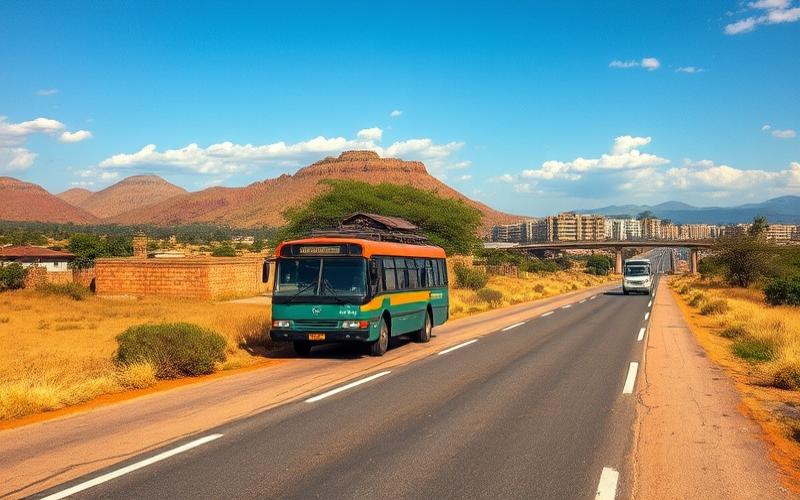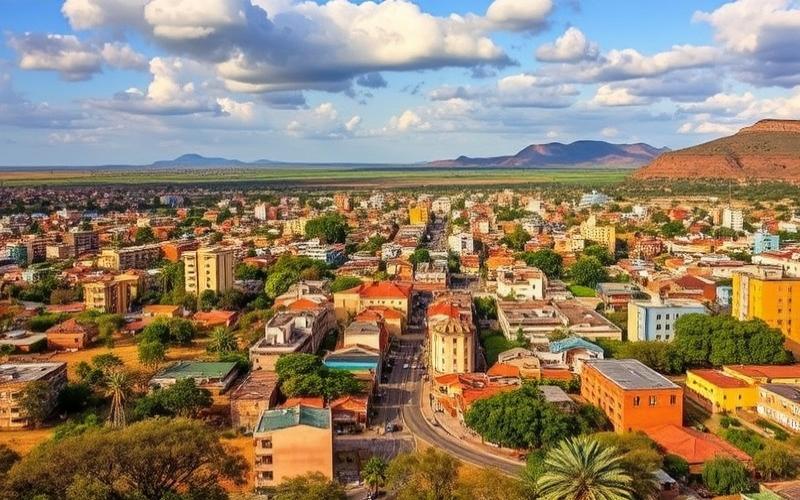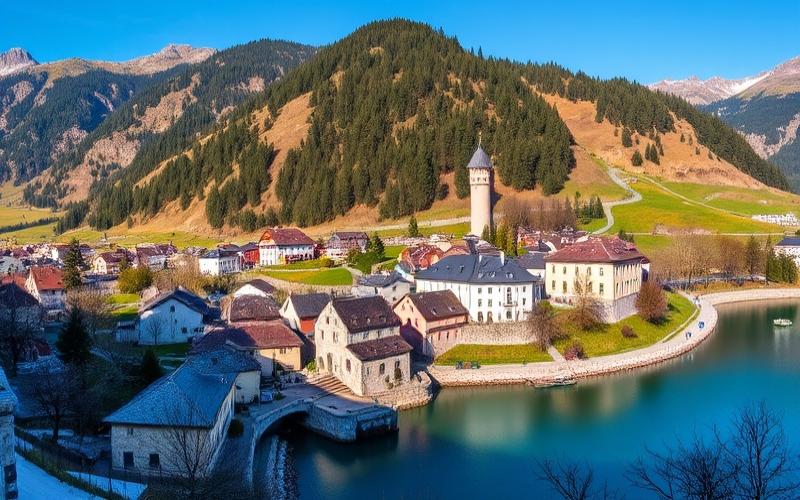
 Published on and written by Cyril Jarnias
Published on and written by Cyril Jarnias
South Africa, a country of breathtaking landscapes and unique cultural diversity, offers visitors an adventure that often begins with its dynamic and complex public transportation network. Whether you’re exploring the vibrant cities of Johannesburg, Pretoria, or the beauty of Cape Town, understanding how the bus systems, trains, and minibus taxis work can transform your trip into a much more rewarding experience. Through this practical guide, discover how to efficiently navigate these modes of transport while learning tips to optimize your safety and comfort during your travels through the heart of this fascinating nation.
Transportation Modes in South Africa: A Range for Every Traveler
The main available public transportation means in South Africa offer a range suited to all travelers, with distinct characteristics based on needs and budgets.
Comparative Table of Public Transportation Modes
| Transport Mode | Availability | Accessibility | Cost | Advantages | Disadvantages |
|---|---|---|---|---|---|
| Minibus-taxis | Widespread in cities and townships, reduced service on weekends. Frequent departures during peak hours. | Accessible without reservation, multiple stops, serve small and large urban centers. | Low cost per trip. | High flexibility; very economical; dense network. | Frequent overcrowding; variable safety; limited comfort for long trips. |
| Metrorail Trains | Present in major urban areas (Johannesburg, Cape Town). Regular schedules but sometimes disrupted. | Accessible from central stations, affordable tickets. | Very affordable for daily commutes. | Suitable for home-to-work travel; inexpensive. | Uneven reliability; occasional maintenance or safety issues; limited network outside major cities. |
| Public Buses | Cover large cities and intercity routes; fixed schedules. | Tickets sold at agencies or on board; comfort varies by company. | Moderate to high depending on distance and class chosen. | Comfort on long distances (e.g., Greyhound); punctuality; possible discounts for students/seniors. | Sometimes long trips (e.g., Johannesburg-Cape Town >20h); bus stations sometimes unsafe at night. |
- Minibus-taxis are the backbone of local urban transport: they depart once full without needing reservations, ensuring accessibility even in outlying neighborhoods.
- Metrorail trains mainly handle short trips within metropolitan areas but suffer from irregular maintenance.
- Intercity buses like Intercape or Greyhound efficiently connect all major cities with several daily rotations and offer good comfort for crossing the country.
- “Hop-on hop-off” shuttles such as Baz Bus specifically target individual tourists wanting to freely stop between two major destinations.
Ridesharing Services
Ridesharing is popular among locals and travelers looking to share costs or find a ride outside standard hours—often organized via hostel bulletin boards or dedicated platforms.
Advantages/Disadvantages by Traveler Profile
- Tourists: prefer hop-on/hop-off buses (flexibility), long-distance buses (comfort), tourist train Shosholoza Meyl.
- Local residents: mostly opt for minibus-taxis (low price) or Metrorail if available.
- Business travelers: use planes between metropolitan areas for speed despite higher cost.
Infrastructure & Recent Innovations
South Africa is heavily investing in urban railway modernization around the Gautrain in Johannesburg–Pretoria (modern express train) as well as safety improvements on certain major road routes.
Pilot projects are gradually integrating contactless mobile payment in urban public transport and increased connectivity via mobile apps facilitating multimodal planning.
List of Recent Innovations:
- Implementation of the Gautrain
- Expansion of electronic payment
- Development of onboard Wi-Fi networks on main lines
Thus, each mode has its specific strengths—economic, practical, or fast—allowing travelers to adapt their choice to the dynamic South African context while considering the locally available infrastructure.
Good to Know:
Minibus-taxis are widely used and offer flexible hours, while Metrorail trains are affordable but often unreliable; public buses mainly serve urban areas, and ridesharing services like Uber are accessible and practical, though sometimes costly for longer trips. Transport infrastructure is modernizing with projects like the Gautrain in Johannesburg, promising a faster and more efficient transport network.
Transport Budget for Expatriates: How Much to Budget?
Available Public Transportation in South Africa:
- Urban and Intercity Buses
- Major companies: Greyhound, Intercape, City to City, Translux.
- Hop-on/hop-off service: Baz Bus (ideal for expatriates or tourists, multiple stops on the same route).
- Average Fares:
- Urban/local: around 10 to 30 ZAR per trip.
- Intercity (Johannesburg – Cape Town, ±1400 km): from 400 to over 700 ZAR depending on class and season.
- Baz Bus: passes valid for several days/weeks, starting around 3000 ZAR depending on duration.
- Minibus taxis (“shared taxis”)
- Main popular and economical transport means, serving cities and outskirts.
- Frequent departures when the vehicle is full. No reservation needed.
- Average Fares:
- Urban/local: around 10 to 20 ZAR per short trip (varies by distance).
- Intercity: rarely used for very long distances, but up to ±150 ZAR on regional routes.
Trains
| Network | Area Served | Indicative Fares |
|---|---|---|
| Metrorail | Major urbanized areas (e.g., Cape Town, Johannesburg) | From ~8–15 ZAR/local trip |
| Gautrain | Johannesburg ↔ Pretoria & O.R. Tambo Airport | ±30–200 ZAR depending on distance/single trip |
| Shosholoza Meyl | Connections between major national cities | From about 400 ZAR/2nd class |
Subscriptions / Discounts
Monthly subscriptions available on certain urban networks (Gautrain offers a rechargeable card with discounted rates).
- Gautrain example: monthly pass between Sandton and Pretoria around 2500–3000 ZAR/month.
- Metrorail offers “monthly” or “weekly tickets” valid on a defined route (~100–500 ZAR/month depending on the trip).
- Common discounts for students (-10% to –15%) and seniors upon presentation of appropriate proof.
Private Modes & Cost Comparison
| Mode | Average Daily Rate |
|---|---|
| Car rental | Between 350–600 ZAR/day (+ fuel) |
| Ridesharing | Variable shared costs (~200+ ZAR/long-distance trip) |
| Uber/Bolt/urban app taxis | Local rides from ~35–60 ZAR; Airport-downtown trips >200 ZAR |
For a single person mainly making daily urban trips, exclusive use of a private vehicle is much more expensive than standard public transport.
Tips to Optimize Your Transport Budget:
- Prioritize advance purchase of intercity tickets to benefit from the best fares.
- Use weekly or monthly subscriptions if you regularly make the same route.
- Compare trips and prices via mobile apps such as Moovit or Google Maps, which sometimes integrate real-time bus/train/minibus schedules in certain South African metropolitan areas.
- For groups/families/travel outside major cities: prefer shared car rental to optimize costs per kilometer traveled while enjoying great logistical flexibility.
Good to Know:
Public transport like minibus taxis costs on average 10 to 20 ZAR for urban trips, while trains and buses have advantageous monthly subscriptions, offering discounts for students and seniors. Prioritize buying passes in advance and use mobile apps to optimize your trips, comparing costs with ridesharing or car rental services, which are generally more expensive.
Tips for a Stress-Free Trip: Practical Advice for Users
Tips for a Stress-Free Trip on Public Transport in South Africa
Personal Safety
- Prefer reputable safe transport: use the Gautrain between Johannesburg, Pretoria, and O.R. Tambo Airport, or tourist trains like the Blue Train or Rovos Rail.
- Avoid unofficial minibus-taxis and unlicensed taxis; always book through a hotel or recognized company.
- Do not travel alone at night, especially in large cities.
- Keep valuables out of sight, bags at your feet, doors locked, and windows closed in taxis.
- Avoid bus and train stations after 5 PM, remain vigilant during the day.
Time Management and Planning
- Anticipate travel considering significant distances between neighborhoods or cities.
- Allow extra time for delays, especially during peak hours.
- Break up long trips to limit fatigue (e.g., 12-hour bus ride between Cape Town and Port Elizabeth).
- Plan routes in advance, especially to avoid areas known to be sensitive.
Ticket Purchase and App Usage
- Buy tickets in advance at official stations or via transport network websites/apps (e.g., Gautrain).
- Use mobile apps to track schedules, routes, and delays in real time.
- Preload your transport card to avoid lines.
| Tip | Recommended App/Service | Advantage |
|---|---|---|
| Schedule tracking | Gautrain App, Moovit, Google Maps | Reliable routes, delay alerts |
| Ticket purchase | Gautrain, Uber, Bolt | Secure payment, time-saving |
| Eco-friendly transport | Uber Green, Bolt Green, MyCiTi bus | Reduced carbon footprint |
Eco-Friendly Transport
- Opt for recent urban buses (MyCiTi in Cape Town, Rea Vaya in Johannesburg) that favor less polluting vehicles.
- Prefer walking in safe, well-frequented areas, or short bike trips in suitable neighborhoods.
Adapting to Local Customs and Interactions
- Politely greet other passengers, especially elders (using “Howzit” or “Sawubona”).
- Respect the queue and give up your seat to vulnerable individuals.
- Avoid political or security discussions with strangers.
- Maintain discretion and stay aware of your surroundings, without displaying signs of wealth.
- Learn about the cultural specifics of each city or community to adapt your behavior.
Key Takeaways
Planning your route, choosing official transport, staying vigilant, and using local technology are the keys to a smooth urban travel experience in South Africa.
Good to Know:
Prefer the ‘MyCiTi’ app to track bus schedules in Cape Town and opt for ticket purchases via smart cards to save time. Choose off-peak hours for a more comfortable experience and always keep an eye on your personal belongings for added safety.
Disclaimer: The information provided on this website is for informational purposes only and does not constitute financial, legal, or professional advice. We encourage you to consult qualified experts before making any investment, real estate, or expatriation decisions. Although we strive to maintain up-to-date and accurate information, we do not guarantee the completeness, accuracy, or timeliness of the proposed content. As investment and expatriation involve risks, we disclaim any liability for potential losses or damages arising from the use of this site. Your use of this site confirms your acceptance of these terms and your understanding of the associated risks.





















































